Insect & Disease Conditions Update
Shortly
after the last issue of this bulletin we got news that brought selfish
sadness—Bill Ostrofsky announced he would be retiring. His date of retirement, the first of
November, has come and gone. Now seems like a good opportunity to let readers
know of this change: we have just
prepared our annual highlights for the USDA Forest Service, which they will
compile with additional information and post to their website sometime next
year, and Thanksgiving has put us in a grateful mood.
We
are grateful for the years that Bill dedicated to the job as Maine’s Forest
Pathologist. He approached the job with a passion for pathology and a gift for
service. He was always available to help
us learn more about the world of forest pathology, and we heard from clients
that his availability to them was greatly appreciated. Bill was a champion of this publication and helped
to make sure it got out to you on a regular basis—you’ll probably notice a
change of voice with his absence. We
wish him the best in retirement.
We
are also grateful to you for your contributions to this bulletin and forest
health monitoring: through your reporting of what you see out there affecting
Maine’s forests and trees and participation in projects throughout the year. We wish you and your loved ones a safe,
healthy and happy Holiday Season and the best in the New Year.
In
addition to the 2015 highlights compiled for the Forest Service, you will find
below some requests for assistance and a calendar of events for the coming
months.
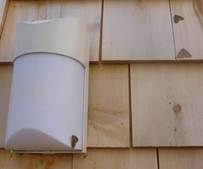
Tracking Winter Moth
Electronic subscribers will have received the Department press
release requesting help from the public to track winter moth, and others may
have seen the news in print or on television. Reminder: the survey can be accessed
online. Reports of moth flights
can also be made by phone at (207) 287-2431.
If
you are east of Rockland or in towns removed from the coast and seeing numbers
of moths we encourage you to collect and submit samples to the lab (Maine Forest Service, 168 SHS, Augusta, ME 04333-0168). Winter moths are very similar to native Bruce spanworm that
might still be flying as well so we need to dissect them to see which species
is present. This could help us better
understand the edges of the current distribution of winter moth. Samples can be mailed in a standard envelope,
information enclosed should include date and location sample collected was
collected from and collector’s name. If information about results is desired,
then contact information (preferably e-mail) should also be enclosed. Samples will be dissected in February.
Photo: Male winter moths rest around an outside light. (Maine Forest Service)
|
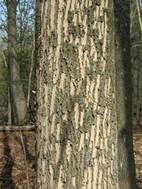
Watching
for Emerald Ash Borer (with the help of woodpeckers)
This
is probably the best time of year to watch for signs of the invasive wood
borer, emerald ash borer (EAB). EAB has
been found just across our borders in New Hampshire and Massachusetts, and we
expect to find it in Maine soon. During
the winter, from this time until the trees start to leaf out in the spring,
woodpeckers often find and feed on overwintering EAB larvae. As they feed, they flick off the grey outer
bark, and expose the light blond inner bark, leaving a distinctive
pattern. When you are out and about,
watch for signs of woodpecker feeding and let us know if you see any. If you can, take a picture of any feeding you
see on ash and pass it on to us.
Photo: Evidence of woodpecker feeding on ash (Maine Forest Service)
|
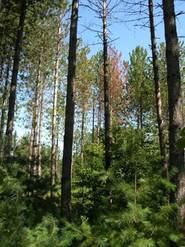 Heterobasidion
Population Genomics Study
Research scientists at the Canadian Forest Service Laurentian Forestry Centre have approached us about participating in their study to unravel patterns of movement of Heterobasidion spp. fungal spores. Infection by these fungi can kill trees causing openings within stands. These openings have informally been dubbed “Fomes holes” (this fungus was once called Fomes annosus).
We’re
looking for stands thought to have Fomes
holes that we can scour for fruiting bodies (conks) to help our neighbors (and
therefore ourselves) learn more about this disease complex. These will most likely be red pine stands,
but other conifers are also susceptible to Heterobasidion
spp. and may have Fomes holes as
well. If you know of potential areas to carry out this work, please let us
know. Collections could start
immediately, so we are interested in leads you may have as soon as
possible. However, this study will
continue through spring 2017, so we’re also interested on sites you may
remember or come across in the future.
The
GPS coordinates of selected sites would be shared with Canadian cooperators and
a conk would be collected from each Fomes
hole and sent to a lab for genetic analysis.
Collection of the fruiting bodies may involve minor soil excavation and
wounding of (doomed) trees. Contact
Allison Kanoti, allison.m.kanoti@maine.gov or (207) 827-1813, with question
or information regarding potential sites.
Photo: A stand opening caused by Heterobasidion spp. root disease, Freeman Twp., ME. (W. Ostrofsky, Maine Forest Service)
Back to Top
|
Winter is a time for meetings;
for us that means we get to speak to a lot of you. For you, that can mean a chance to ask your
questions in person, and sometimes even get some continuing education or
licensing credits. Here is an incomplete
schedule of our talks for the next few months:
Agricultural
Trades Show in Augusta, ME -- This
free event runs from January 12th
through the 14th. There are many workshops that might be of
interest. The full schedule for the
trades show will be linked on this website when it is available. Colleen Teerling will speak to the Maine Maple
Syrup Producers on Tuesday January 12th on forest
pests both invasive and native that can affect maple trees. The exact time has not yet been decided, but
will be sometime between 9 and 11 am. On
Wednesday, January
13th, Allison Kanoti will be presenting a Forest Health
Update for the Board of Pesticides Control Workshop (1 CEU for pesticide
licensees) from 10:15 -11:15. That same
day, she’ll present an update at the SWOAM Annual Meeting from 2:45
to 3:30.
Grow Maine Green Expo in Augusta ME. On Wednesday, January 20th,
Colleen Teerling will present a talk at the joint meeting of the Maine
Arborists Association and Maine Landscape & Nursery Association. She will talk about invasive insects which
impact arborists and landscapers and how they in turn impact those insects. The day will include a keynote address,
educational seminars and a B2B trade show.
More information can be found at the MAA website.
New
England Regional Conference on Forest Engineering, Orono, ME – Allison Kanoti will provide a
brief forest health update at the NERCOFE conference in Orono on March
14th. More
information on the full conference will be available on the University of Maine
website.
Winter
Ag School, Houlton, ME – Charlene Donahue will provide
an update on the Spruce Budworm Situation in Maine and Canada at the forestry
session of the Southern Aroostook Soil and Water Conservation District (SASWCD)
Winter Ag School. The session will take
place at the Houlton Higher Education building at 18 Military St. from 6:00pm-9:00pm
on Thursday, March 31st. Credits
pending for licensed foresters, CLP and QLP.
For more information contact Angie Wotton at the SASWCD: 532-2087 ext.101
or angela.wotton@me.nacdnet.net.
Ash
Peeling Workshops, Various, ME –
Dates and locations for the ash trap tree peeling workshops will be announced
at a later date. If you created a trap
tree in 2015 and haven’t already contacted Patti Roberts with details, please
contact Patti: (207) 287-2431 or patti.roberts@maine.gov. You can also contact Patti also if you
haven’t created a trap tree, but are interested in helping peel trees at a
workshop.
Back to Top
2015
Forest Health Highlights
Report to the USDA Forest Service of Forest Health Conditions
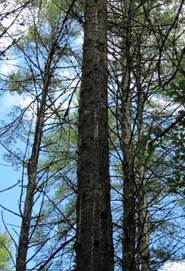 Caliciopsis Canker of White Pine
Caliciopsis canker (Caliciopsis
pinea) is a disease that has been historically associated with overstocked,
pole-sized white pine stands of low vigor.
More recently, it has been observed to be more aggressive in some
situations, so a re-examination study of the disease was initiated, with the
USDA Forest Service, New Hampshire Division of Forests and Lands, Maine Forest
Service, and the University of Maine as cooperators. The survey and research
effort is on-going in both Maine and New Hampshire. A summary of only the Maine Forest Service
efforts are outlined here.
In 2014,
22 randomly selected stands were surveyed in Maine, with Caliciopsis pinea identified on white pine regeneration from 16
stands surveyed. Caliciopsis symptoms
in overstory trees were also identified in 16 stands, but not always from those
with infected white pine regeneration. Relationships between tree stress
resulting from the white pine needle disease complex, and the incidence and
severity of Caliciopsis canker have
not been established, but may become apparent as studies continue.
In 2015, the
study was expanded to assess Caliciopsis canker incidence and severity as it
may be related to soil type characteristics.
An additional 16 white pine stands were surveyed for the canker disease
in Maine and the data will be combined with similar data collected in New
Hampshire by USDA Forest Service and New Hampshire DRED personnel. Of the 16 plots surveyed in Maine this year,
fruiting of the pathogen was found on sapling–sized white pines in ten of the
stands. Symptoms of pitching (pitch
streaks along the main bole) were observed in all sixteen stands. Percentage of white pines exhibiting pitching
ranged from a low of 10% in a stand in Lyman, to73% in a stand in
Shapleigh. Although pitching is one
criterion for assessing infection by Caliciopsis, not all pitching is likely
the result of infection by this pathogen.
Detailed canker analyses are being conducted by University of Maine,
other State, and USDA Forest Service cooperators to determine the reliability
of using pitching as a survey tool for this disease.
Photo: Inter-nodal pitch streaks on the bark of white pine, a symptom of infection by Caliciopsis pinea Limington, Maine. (Maine Forest Service Photo)
|

White Pine Needle
Cast and Needle Blight
The needle disease complex that has resulted
in extensive pre-mature needle shedding in white pines over the past several
years continued at a similar level of intensity in 2015. Losses of one-year-old needles during late
May and through June resulted in numerous disease clinic requests for
assistance. This is believed to be the
ninth consecutive year of heavy needle loss in Maine from this disease complex. As part of a region-wide study coordinated by
USDA Forest Service personnel, two permanent plots in Maine were again assessed
for white pine needle disease symptoms.
The disease complex was also noted when conducting the survey for Caliciopsis pinea (described above in
this report). The disease remains widespread but most severe throughout
central, western, and southern Maine.
An extensive survey in Downeast and northern regions of Maine indicated
disease presence wherever white pine was found, but disease intensity in these
regions was judged to be considerably less than in southern and western areas.
Photo: Yellow needles in June is a symptom of the needle disease complex that has been affecting eastern white pine in the region, Augusta, Maine. (Maine Forest Service Photo)
|
Other
Disease Issues of Note
In an upcoming issue, Plant Disease is set to publish a first report of the pathogen Diplodia
corticola in Maine. Symptoms
of oak dieback were observed in Standish (Cumberland County) and a few
surrounding towns in 2015. Symptoms
include the drying and death of leaves and branch tips, often with a clearly
delimited canker separating the dead portion from the live portion of the
branch. Leaves on affected branches
become brown and persist on the tree, at least for several weeks. Occasionally, twigs of branches more proximal
to the stem are affected first, rather than those at the branch tip
itself. Although no positive
identification was made on material from Standish, it is very likely that the
causal agent for this dieback is Diplodia
corticola (=Botyrosphaeria corticola). This disease is generally considered to be a
secondary agent, affecting trees initially weakened or damaged by some other
cause. A First Look of the Plant Disease
article can be found here.
Sirococcus shoot blights remain
notable in Maine, particularly Sirococcus conigenus on red pine and
S.
tsugae on hemlock. Red pine in
both natural and planted stands have experienced significant decline and
mortality in locations scattered throughout the state due at least in part to S. conigenus. Hemlock regeneration has
been compromised by S. tsugae in
scattered locations in Maine, especially in coastal areas.
Back to Top
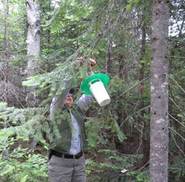
Spruce Budworm
Spruce
budworm is a periodic major pest of fir and spruce in Maine. The Maine Forest
Service has been monitoring this insect since the early part of the last
century. Since 1992 we have been using pheromone traps and catches have
averaged well below five moths/trap across the northern part of the State. In
2011 that average crept up to over five moths/trap and this year the average is
27 moths/ traps; up slightly from 25 moths/trap in 2014. All of the sites had
some spruce budworm moths.
For the second year the Maine
Forest Service has asked large land owners and managers in northern Maine to
help survey for spruce budworm by setting out pheromone traps on their lands.
We request one three-trap sample per six mile-square township set in at least a
25 acre spruce/fir stand that was composed of more than 50 percent spruce/fir
pole-sized or larger trees. This year 19 entities participated in setting out
over 1,300 traps at 452 sites. An additional 129 traps used in a research
project were included in the tally as well.
Photo: Spruce budworm pheromone traps are hung in spruce/fir stands that are more than 25 acres in size and have at least 50 percent pole-sized or larger spruce/ fir. (Maine Forest Service Photo)
The overall average moths/trap was 25.7 moths/
trap with 98% of the traps positive for spruce budworm. The townships with the
most moths are in Aroostook and Piscataquis Counties. The number of traps with
over 100 moths has gone from six in 2014 to 17 in 2015 and the number of traps
with over 50 moths has doubled.
Table 1. Number of spruce budworm moths in pheromone traps by county
- Aroostook: 25.8 (2014), 44.9 (2015)
- Franklin: 0.8 (2014), 0.5 (2015)
- Hancock: 2.4 (2014), 4.9 (2015)
- Oxford: 1.1 (2014), 1.3 (2015)
- Penobscot: 6.1 (2014), 15.1 (2015)
- Piscataquis: 10.7 (2014), 20.4 (2015)
- Somerset: 13.2 (2014), 6.2 (2015)
- Washington: 3.2 (2014), 7.1 (2015)
- Grand Total: 15.7 (2014), 25.7 (2015)
No spruce budworm damage was detected either in ground or aerial surveys. The University of Maine spearheaded an overwintering larval survey (called L2 for the larval instar collected). Land managers had crews take three mid-crown branch samples from 100 of the most at risk sites. Branch samples were sent Canada for processing. Eight larvae were found, all in townships in Aroostook County.
Table 2. Number of spruce budworm larvae found in 300 branch samples in winter of 2014/15
- Westmanland: 3
- St. Francis: 2
- T14 R13 WELS: 1
- T14 R8 WELS: 1
- T12 R12 WELS: 1
Maine is poised at the beginning of another spruce budworm outbreak. Outbreaks occur on a roughly 40 year cycle in response to maturing forest stands and reduced pressure from parasites; the last time budworm was a problem in Maine was in the 1970’s and 80’s. This native defoliator of balsam fir and spruce has been defoliating trees in Quebec north of the Saint Lawrence Seaway for more than 10 years. Defoliation, which has spread to the south shore, currently covers more than 15 million acres. New Brunswick is seeing increased numbers of budworm moths in their pheromone traps and may see light amounts of defoliation in the northern part of the province in 2016.
|
 Winter Moth
Winter moth is firmly established
along the southern coast of Maine from Kittery (York County) to Bar Harbor
(Hancock County) and on many offshore islands. Although more acres of
defoliation were mapped this year than last, the intensity was not as
severe. I.e. Many trees were not as
heavily defoliated as last year but there was a broader footprint across the
landscape. In ground surveys defoliation ranged from light to heavy from Kittery to Rockland
(Cumberland, Knox, Lincoln, Sagadahoc and York Counties). Heaviest damage was in Cape Elizabeth, Peaks
Island in Portland, Harpswell and Chebeague Island (Cumberland County). Total
area mapped in aerial survey was 10,264 acres, all in Cumberland County.
The
Maine Forest Service ran a pheromone trap survey in December 2014 to determine
where winter moth populations were heaviest and to delineate the outer reaches
of the infestation. Traps were deployed at 75 locations in towns along the
coast and along a transect inland from known infested areas. The survey covered coastal portions of York,
Cumberland, Sagadahoc, Lincoln, Knox, Waldo and parts of Hancock, Androscoggin
and Kennebec counties. At the same time, reports of moth observations were
solicited from the public using a Survey Monkey form—over 700 reports were
received through this method. A map
predicting intensity of defoliation was produced from these surveys to help green
industry professionals and homeowners prepare for the growing season.
Parasitic
flies, Cyzenis albicans, were
released for the third year in Maine in cooperation with Dr. Joseph Elkinton,
University of Massachusetts and funded by the USDA. Releases were made in two towns in Cumberland
County: Peaks Island - Portland 2,000 flies and Two Lights State Park, Cape
Elizabeth 2,000 flies. Locations where flies had been released in previous
years were sampled for parasitoids.
Photo: Winter moth damage spotted from aerial survey in Harpswell, Maine. (Maine Forest Service photo)
|
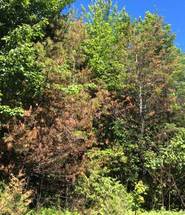 Pine Leaf Adelgid
Pine leaf
adelgid is a native adelgid which depends on eastern white pine and red or
black spruce to complete its lifecycle.
Growth impacts to spruce are limited and occasionally growth impacts to
white pine can be significant. In recent
years populations have been building in parts of Maine. This has happened before. The 1968 Maine Agricultural Experiment
Station Bulletin 658 reports on a waning outbreak of the pine leaf
adelgid. The report states that radial
growth impacts to eastern white pine began in 1955, populations of the adelgid
peaked in 1961 were still declining in 1968 (Dimond and Bishop 1968).
The current build-up was first noticed in 2012 in
the north end of Baxter State Park and was reported in the September issue of
the Maine Forest Service’ Conditions
Report. 2015 was the year the public
and natural resources professionals began to notice and report the pest over a
wide area. Damage ranges from reddening
and wilting of just a few shoots on individual trees, to widespread dieback of
the majority of shoots on seedling and small pole-sized trees as well as some
pockets of mortality. Surveys in 2015
showed severe damage to white pine scattered over more than a quarter of a
million acres of forest. Reports
indicate that lighter damage covers an even broader extent. The most severe damage is confined to
Piscataquis County in an area west of Baxter State Park.
We expect to see significant damage from this pest
for years to come; the outbreak that began in the 1950’s lasted more than 10
years.
Photo: Eastern white pine with severe damage from pine leaf adelgid, T6 R13 WELS, Maine. (Maine Forest Service Photo)
Other Insects Issues
of Note
2015 marked one more trapping and field season
without detection of emerald ash borer (EAB) in Maine. That was not due to a lack of trying. Seven hundred ten purple traps, 20 green
funnel traps, 24 trap trees and 25 biosurveillance sites were used in EAB
monitoring in Maine in 2015. In addition, public education and awareness
efforts have remained a key part of our detection strategy.
Two other invasive insects have been making an
impact on our forests and communities in a very similar footprint to the winter
moth presence in Maine—hemlock woolly adelgid and browntail moth.
Hemlock woolly adelgid is established in Maine
forest hemlocks at least from Kittery to Camden—roughly 1/3 of the coastline in
Maine. Declining hemlocks can be found
in many coastal peninsulas where warmer winter weather and drier soil
conditions help speed decline. A new
regional publication funded by a USFS grant on management of threatened hemlock
has recently been made available on-line: Managing
Hemlock in Northern New England Forests Threatened by Hemlock Woolly Adelgid
and Elongate Hemlock Scale.
Browntail moth populations show signs of increase in many coastal communities. Winter web counts were moderate to
high in small areas of Bath, Bowdoinham Topsham and West Bath (Sagadahoc
County) and Brunswick and Freeport (Cumberland County) again in the winter of
2014-15. Defoliation was mapped on only
90 acres in Cumberland County this spring in Freeport. But in September over 10,000 acres of
defoliation by first instar larvae was mapped in Sagadahoc and Cumberland
Counties. This level of fall defoliation has not been seen since the early
2000’s. Winter web surveys will verify
the size of the footprint of this now perennial problem. There is concern that
expanding browntail moth populations combined with winter moth will have a
severe impact on oak trees in the midcoast region.
References:
Dimond,
J.B., and R.H. Bishop. 1968. Susceptibility and vulnerability of forests to the
pine leaf aphid, Pineus pinifoliae
(Fitch) (Adelgidae). Maine Agricultural Experiment Station Bulletin 658.
Back to Top
|
Conditions Report No. 5, 2015
|